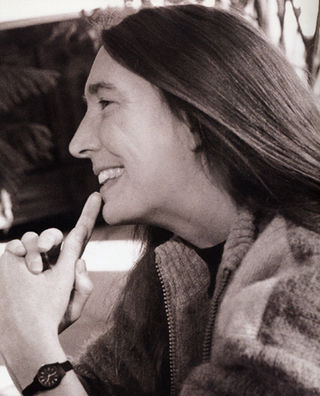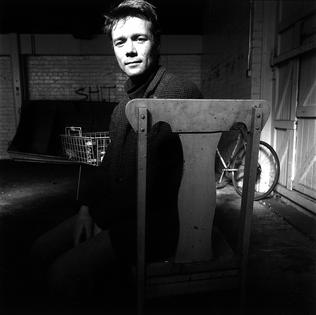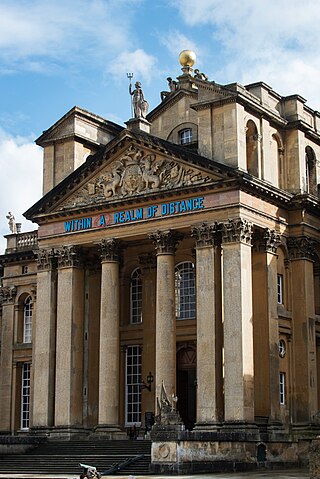Peter Nadin (born 1954) is a British-born American artist, poet, and farmer.
Contents

Peter Nadin (born 1954) is a British-born American artist, poet, and farmer.

Nadin was born in Bromborough, in northwest England He studied fine art at Newcastle upon Tyne University from 1972 to 1976, before moving to New York. [1] [2]
From 1977 to 1978 Nadin worked as a construction worker, along with the artist Christopher D’Arcangelo, with whom he began collaborating at the time. Together, they established a non-commercial gallery in Nadin’s Tribeca loft at 84 West Broadway, New York. [3]
In this space, artists and musicians were invited to respond to the conditions they found in the gallery. Friends and guests were invited to stay and live there among work by artists such as Daniel Buren, Sean Scully and Dan Graham, with each new work responding to works installed earlier in the space; none of the work was for sale and everything remained in the gallery. [4]
Nadin then began a consulting office offering practical aesthetic services in a short-lived artist consulting office collective with Jenny Holzer, Richard Prince, Peter Fend, Coleen Fitzgibbon, and Robin Winters. [5] During this time he also worked collaboratively with Jenny Holzer publishing three books. [6]
Nadin’s principal medium throughout the 1980s was painting, although he also produced sculpture and published poetry, including “Poetry Room,” a one-year installation at American Fine Art Gallery. [7]
Although his work from this time passed through a variety of styles, its primary focus is the representation of consciousness through painterly marks—a theme that Nadin returned to throughout his career. [4]
He had solo exhibitions at the Institute of Contemporary Art in Boston and the Yale Center for British Art in New Haven, and showed at Brooke Alexander Gallery in New York. He also participated in many group shows, including the 1988 Venice Biennale. [8]
In 1992, Nadin ceased to exhibit his art and turned to farming. He acquired Old Field Farm, a farm dating to the early 19th century in Cornwallville, a hamlet in the northern Catskills of New York. [8]
Through the 1990s and 2000s Nadin expanded the farm, on which he raises pigs, chickens, ducks, cashmere goats, and bees. Nadin eventually founded Old Field Farm/Art & Agriculture, which provides meat, produce, honey and other farm products to local restaurants and markets. [9]
Although he stopped exhibiting during this period, Nadin continued to make art, often influenced directly by his work as a farmer. His paintings included materials directly from the farm, such as cashmere from his goats or wax from his bees. [10]
In 2006 Nadin published The First Mark: Unlearning How to Make Art, a book that combines cultural criticism with discursive takes on the process of art making and human behavior. [11] That year Nadin traveled to Cuba, not as an artist, but as a delegate to the South American Beekeepers’ Conference. [12] While in Havana he was invited to exhibit his art at the Wifredo Lam Center, and in 2007 he presented a show entitled First Mark. [13] First Mark traveled to other Cuban cities—Pinar Del Río, Matanzas, Holguín, and San Antonio de los Baños—and later to Cuenca, Ecuador. [14]
After an absence of almost 20 years, Nadin held his first exhibition in New York in 2011 at Gavin Brown’s enterprise in the West Village. [3] [15]

Wifredo Óscar de la Concepción Lam y Castilla, better known as Wifredo Lam, was a Cuban artist who sought to portray and revive the enduring Afro-Cuban spirit and culture. Inspired by and in contact with some of the most renowned artists of the 20th century, including Pablo Picasso, Henri Matisse, Frida Kahlo and Diego Rivera, Lam melded his influences and created a unique style, which was ultimately characterized by the prominence of hybrid figures. This distinctive visual style of his also influences many artists. Though he was predominantly a painter, he also worked with sculpture, ceramics and printmaking in his later life.

The Saatchi Gallery is a London gallery for contemporary art and an independent charity opened by Charles Saatchi in 1985. Exhibitions which drew upon the collection of Charles Saatchi, starting with US artists and minimalism, moving to the Damien Hirst-led Young British Artists, followed by shows purely of painting, led to Saatchi Gallery becoming a recognised authority in contemporary art globally. It has occupied different premises, first in North London, then the South Bank by the River Thames, and finally in Chelsea, Duke of York's HQ, its current location. In 2019 Saatchi Gallery became a registered charity and began a new chapter in its history. Recent exhibitions include the major solo exhibition of the artist JR, JR: Chronicles, and London Grads Now in September 2019 lending the gallery spaces to graduates from leading fine art schools who experienced the cancellation of physical degree shows due to the pandemic.

The Museum of Contemporary Art, Los Angeles (MOCA) is a contemporary art museum with two locations in greater Los Angeles, California. The main branch is located on Grand Avenue in Downtown Los Angeles, near the Walt Disney Concert Hall. MOCA's original space, initially intended as a temporary exhibit space while the main facility was built, is now known as the Geffen Contemporary, in the Little Tokyo district of downtown Los Angeles. Between 2000 and 2019, it operated a satellite facility at the Pacific Design Center facility in West Hollywood.

Jenny Holzer is an American neo-conceptual artist, based in Hoosick, New York. The main focus of her work is the delivery of words and ideas in public spaces and includes large-scale installations, advertising billboards, projections on buildings and other structures, and illuminated electronic displays.

Rick Amor is an Australian artist and figurative painter. He was an Official War Artist for Australia.

John Kirk Train Varnedoe was an American art historian, the chief curator of painting and sculpture at the Museum of Modern Art (MoMA) from 1988 to 2001, Professor of the History of Art at the Institute for Advanced Study in Princeton, New Jersey, and Professor of Fine Arts at the New York University Institute of Fine Arts.

The Gagosian Gallery is a contemporary art gallery owned and directed by Larry Gagosian. The gallery exhibits some of the most influential artists of the 20th and 21st centuries. There are 18 gallery spaces – six in New York City, two in London, three in Paris, and one each in Basel, Gstaad, Beverly Hills, Rome, Athens, Geneva and Hong Kong.

Ronnie Landfield is an American abstract painter. During his early career from the mid-1960s through the 1970s his paintings were associated with Lyrical Abstraction, and he was represented by the David Whitney Gallery and the André Emmerich Gallery.
The Art of This Century gallery was opened by Peggy Guggenheim at 30 West 57th Street in Manhattan, New York City on October 20, 1942. The gallery occupied two commercial spaces on the seventh floor of a building that was part of the midtown arts district including the Museum of Modern Art, the Museum of Non-Objective Painting, Helena Rubinstein's New Art Center, and numerous commercial galleries. The gallery exhibited important modern art until it closed in 1947, when Guggenheim returned to Europe. The gallery was designed by architect, artist, and visionary Frederick Kiesler.
Joe Bradley is an American visual artist, known for his minimalist and color field paintings. He is also the former lead singer of the punk band Cheeseburger. Bradley has been based in New York City and Amagansett.
Rob Pruitt is an American post-conceptual artist. Working primarily in painting, installation, and sculpture, he does not have a single style or medium. He considers his work to be intensely personal and biographical.
Jonathan Horowitz is a New York-based artist working in video, sculpture, sound installation, and photography. Horowitz critically examines the cultures of politics, celebrity, cinema, war, and consumerism. From found footage, Horowitz visually and spatially juxtaposes elements from film, television, and the media to reveal connections and breakdowns between these overlapping modes of communication.

Sasson Soffer (1925–2009) was an American abstract painter and sculptor. His work has been exhibited extensively throughout the world.
Coleen Fitzgibbon is an American experimental film artist associated with Collaborative Projects, Inc.. She worked under the pseudonym Colen Fitzgibbon between the years 1973–1980.
Robin Winters is an American conceptual artist and teacher based in New York. Winters is known for creating solo exhibitions containing an interactive durational performance component to his installations, sometimes lasting up to two months. As an early practitioner of Relational Aesthetics Winters has incorporated such devices as blind dates, double dates, dinners, fortune telling, and free consultation in his performances. Throughout his career he has engaged in a wide variety of media, such as performance art, film, video, writing prose and poetry, photography, installation art, printmaking, drawing, painting, ceramic sculpture, bronze sculpture, and glassblowing. Recurring imagery in his work includes faces, boats, cars, bottles, hats, and the fool.
Kevin Larmon is an American artist and was assistant monitor of painting at Syracuse University.

David Larwill (1956–2011) was an Australian artist recognisable by his distinctive and exuberant style based on bold colour, stylised figures and simplified form. Although best known as a figurative expressionist painter, Larwill was also a draughtsman and printmaker of note. He produced many drawings, watercolours, ceramics and sculptures as well as etchings, lithographs and screenprints. In a career that stretched over 30 years, Larwill held over 25 solo exhibitions and participated in scores of group shows.

Dismaland was a temporary art project organised by street artist Banksy in the seaside resort of Weston-super-Mare in Somerset, England. Prepared in secret, the pop-up exhibition at the Tropicana, a disused lido, was "a sinister twist on Disneyland" that opened during the weekend of 21 August 2015 and closed on 27 September 2015, 36 days later. Banksy described it as a "family theme park unsuitable for children." The aesthetic of the "bemusement park" was potentially inspired by the "Dismayland" series of paintings created by American artist Jeff Gillette, who also participated in the exhibition.

Blenheim Art Foundation (BAF) is a multi-award-winning non-profit organisation that presents large-scale contemporary art exhibitions at Blenheim Palace.

The Times Square Show was an influential collaborative, self-curated, and self-generated art exhibition held by New York artists' group Colab in Times Square in a shuttered massage parlor at 201 W. 41st and 7th Avenue during the entire month of June in 1980. The Times Square Show was largely inspired by the more radical Colab show The Real Estate Show, but unlike it, was open 24 hours a day, 7 days a week, in what was then a Times Square full of porno theaters, peep shows, and red light establishments. In addition to experimental painting and sculpture, the exhibition incorporated music, fashion, and an ambitious program of performance and video. For many artists the exhibition served as a forum for the exchange of ideas, a testing-ground for social-directed figurative work in progress, and a catalyst for exploring new political-artistic directions.